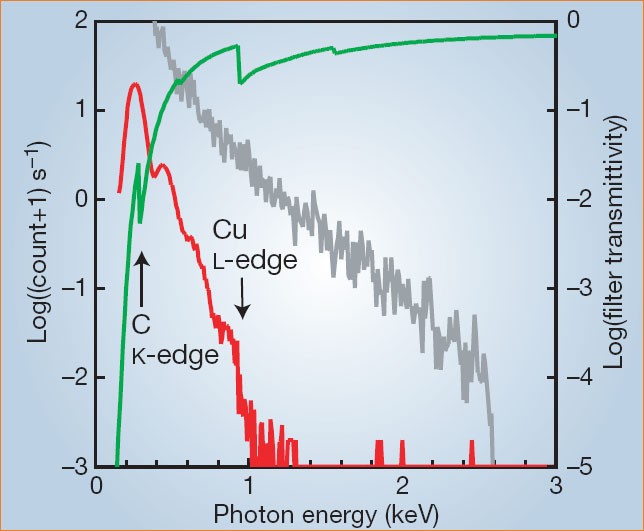Source of coherent kiloelectronvolt X-rays (original) (raw)
High-order harmonic generation in an atomic gas ionized by a femtosecond laser pulse has been successful in generating coherent extreme-ultraviolet radiation1,2. The coherent laser field forces the atoms to radiate waves that oscillate in the same way in a macroscopic volume, resulting in the coherent build-up of extreme-ultraviolet radiation in a collimated laser-like beam. The freed electrons cause the generating laser wave and emerging short-wavelength radiation to travel at different speeds and hence limit the useful interaction length, over which the atomic dipoles radiate in phase. Suppression of this de-phasing effect by suddenly turning on the laser field3, or by modulating the propagation constant in the generation medium4, results in an extension of harmonic emission to several hundred electronvolts.
We advanced the former approach3 by pushing ultrafast laser technology to extend the spectral range of coherent radiation to the kiloelectronvolt regime. A multistage titanium:sapphire laser5 delivers near-infrared pulses of under 15 fs, which are spectrally broadened in a neon-gas-filled capillary and compressed by chirped mirrors in order to obtain 720-nm, 5-fs, 0.2-terawatt pulses at a repetition rate of 1 kHz. The linearly polarized pulses propagate through a 0.4-mm-thick jet of helium atoms (pressure, 0.5 bar; 1/_e_2 diameter of laser beam, _w_0=30 µm). The short-wavelength radiation emerges from the gas jet in a laser-like beam.
We analysed the beam's spectral distribution using energy-dispersive and wavelength-dispersive X-ray spectrometers, which separate different spectral components according to their photon energy or wavelength, respectively. The combination of aluminium, carbon and copper filters with the helium background atmosphere in the vacuum system blocks light that has photon energies below 200 eV before detection (for methods, see supplementary information). From a knife-edge scan across the X-ray beam, we evaluated a beam-divergence angle of 0.2 milliradians for the spectral range above 200 eV . This divergence implies perfect coherence of the atomic dipoles within a macroscopic volume of diameter of ≥ 13 µm and ≥ 4 µm at photon energies of 0.3 keV and 1 keV, respectively. The emitted X-ray beam seems to be diffraction-limited to within a factor of five (see supplementary information).
Figure 1 shows the spectrum of the generated radiation, as transmitted through the filters and recorded with the energy-dispersive X-ray spectrograph. The appearance of the copper L-edge at about 950 eV is evidence for harmonic radiation at 1 keV. X-rays were detected beyond 1.3 keV (see supplementary information). The key to this progress is the temporal intensity gradient in the driving pulse, which allows some 25% of the helium atoms to be ionized within half a cycle before the pulse peak6. The electrons detached within this time are pushed in the most intense half-cycle back to the atomic core. Under these conditions, our simulations6,7 predict harmonic emission from individual helium atoms up to 2.5 keV (Fig. 1).
Figure 1: Photon energy spectrum of coherent soft-X-ray emission from a helium gas (red line), measured using a multichannel analyser (Oxford) and a silicon–lithium semiconductor detector cooled by liquid nitrogen.
The soft X-ray beam is filtered by propagation through 100-cm helium (3 millibar), 100-nm copper and 100-nm aluminium filters and a 300-nm AP1.3 window (including carbon). Green line, overall transmittivity of these filters; grey line, calculated spectrum of radiation emitted by individual helium atoms exposed to 5-fs pulses with a peak intensity of 1.4×1016W cm−2.
We have shown that atoms ionized within a few femtoseconds emit coherent, kiloelectronvolt soft X-rays. As the few-cycle pulse can propagate free of substantial distortion over distances that are several orders of magnitude greater than the de-phasing length in the 1–2 keV spectral range, phase-matching techniques hold promise for increasing the current kiloelectronvolt photon flux of 102–103 photons per second (which is within 10% bandwidth at 1 keV) by several orders of magnitude. Radiation within this band is expected to emerge in a single pulse of less than 100 attoseconds when generated with a waveform-controlled, few-cycle pulse8. This would allow the investigation of a wide range of electronic dynamics in atoms, molecules and solids with near-atomic-scale resolution in time, and possibly simultaneously in space9.
